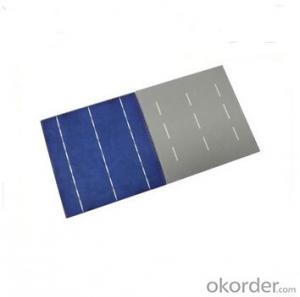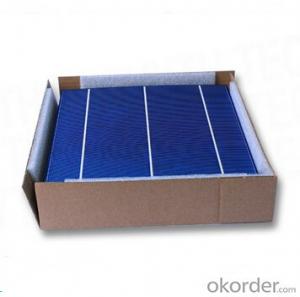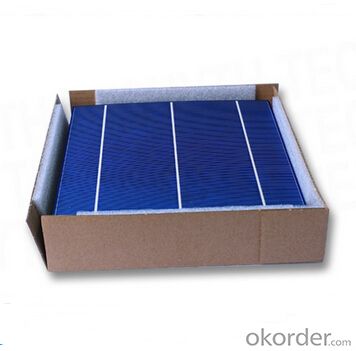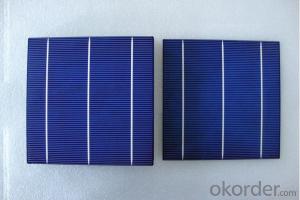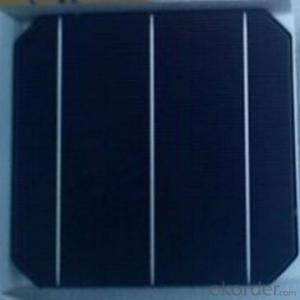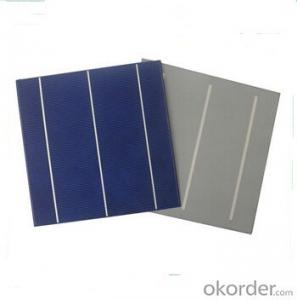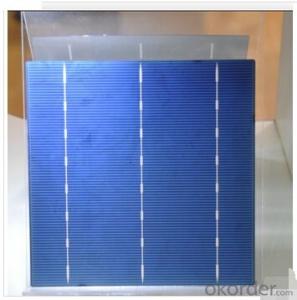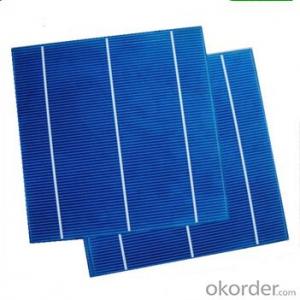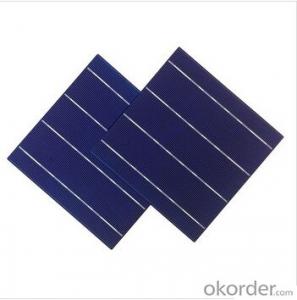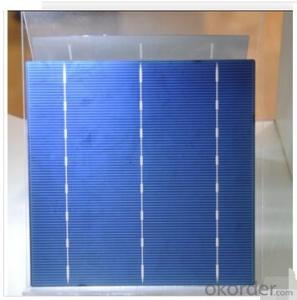High Performance Polycrystalline Solar Cells Series- 18.2%
- Loading Port:
- Shanghai
- Payment Terms:
- TT OR LC
- Min Order Qty:
- 1000 pc
- Supply Capability:
- 100000 pc/month
OKorder Service Pledge
OKorder Financial Service
You Might Also Like
Solar Cells:
Solar cells is made by solar wafer, it has three categories of solar cell right now, monocrystalline polycrystalline and thin film,These cells are entirely based around the concept PN junction, which is the critical part of solar module, it is the part that can convert the light energy into electricity, the thickness is from 180um to 200um, with even busbars to conduct electricity, textured cell can decrease diffuse reflection; they are often electrically connected and encapsulated as a module. Photovoltaic modules often have a sheet of glass on the front (sun up) side, allowing light to pass while protecting semiconductor wafers from abrasion and impact due to wind-driven debris, rain, hail, etc. Solar cells are also usually connected in series in modules, creating an additive voltage. Connecting cells in parallel will yield a higher current;With high quality and stable quality. Our Cells can greatly improve the performance of Solar Modules.
Features:
1. High conversion efficiencies resulting in superior power output performance.
2. Outstanding power output even in low light or high temperature conditions
3. Optimized design for ease of soldering and lamination
4. Long-term stability, reliability and performance
5. Low breakage rate
6. Color uniformity
Solar Cells Advantage:
1. Tire-1 Solar Cells’ Manufacturer Quality Guarantee. With a complete and sophisticated quality government system, our Quality Management have arrived world’s leading place. Customer can receive Tire-1 Cells Maker’s Quality Standard Products.
2. Trusted Warranty. We can supply trusted after-sales service to our customer. If our cells are found not in conformity to the specification of manufacturer, or should the inspected quantity found in shortage, or should the packing found damaged, the buyer has the right to claim to the seller. The claim, if any, should be presented to seller within 30 days after cargo's arrival date to the port, together with related inspection report and photos issued and provided by a reputable independent surveyor such as SGS.
3. World’s Leading Manufacturer Equipment. We imported the newest and leading production equipment from abroad. Advanced equipment can guarantee the stable quality of cells. Auto production line can also save labor cost which will further cut our production cost.
4. Bulk supply: With the production capacity of 500MW, we can produce large quantity every month. This can satisfy most customer requirement.
Specifications:
Dimension | 156mmx156mm±0.5mm |
Thickness(Si) | 180µm ±20µm, 200µm±20µm |
Front | Blue silicon nitride anti-reflective coatings 1.4mm silver busbar |
Back | Full-surface aluminum back-surface field 2.5mm(silver/aluminum discontinuous soldering pads |
Efficiency code | 182 | 180 | 178 | 176 | 174 | 172 | 170 | |
Efficiency | Eff(%) | 18.20 | 18.00 | 17.80 | 17.60 | 17.40 | 17.20 | 17.00 |
Power | Ppm(W) | 4.43 | 4.38 | 4.33 | 4.28 | 4.23 | 4.19 | 4.14 |
Max. Power current | Ipm(A) | 8.26 | 8.22 | 8.17 | 8.12 | 8.08 | 8.05 | 7.99 |
Short Circut Current | Isc(A) | 8.71 | 8.68 | 8.63 | 8.60 | 8.56 | 8.53 | 8.49 |
Max. Power Voltage | Vpm(V) | 0.536 | 0.533 | 0.530 | 0.527 | 0.524 | 0.521 | 0.518 |
Open Cirtuit Voltage | Voc(V) | 0.634 | 0.632 | 0.630 | 0.627 | 0.625 | 0.622 | 0.620 |
FAQ
We have organized several common questions for our clients,may help you sincerely:
①What price for each watt?
It depends on the efficiency of the solar cell, quantity, delivery date and payment terms.
②How long can we receive the product after purchase?
In the purchase of product within three working days, We will arrange the factory delivery as soon as possible. The pecific time of receiving is related to the state and position of customers.Commonly 7 to 10 working days can be served.
③Can you provide the peripheral products of the solar panels, such as the battery, controller, and inverter? If so, can you tell me how do they match each other?
Yes, we can, we have two companies for solar region, one is CNBM International, the other is CNBM engineering Co.
We can provide you not only the solar module but also the off grid solar system, we can also provide you service with on grid plant.
④What is your warranty of solar cell?
Our product can promise lower than 0.3% open box crack, we support claim after opening the box if it has crackm color difference or sth, the buyer should give pictures immediately, we can not accept the claim after the solar cell has assembled to solar panel.
• Timeliness of delivery
• ⑤How do you pack your products?
We have rich experience on how to pack the solar cell to make sure the safety on shipment, we could use wooden box or pallet as buyer's preference.
- Q: Can solar cells be used to power remote monitoring systems?
- Yes, solar cells can be used to power remote monitoring systems. Solar cells convert sunlight into electrical energy, which can be stored in batteries or directly used to power monitoring devices. This makes solar cells a reliable and sustainable solution for remote monitoring systems that require continuous power in areas where grid electricity may not be available or practical.
- Q: What is the impact of hailstorms on solar cells?
- Hailstorms can have a significant impact on solar cells. The high-speed impact of hailstones can cause physical damage, such as cracks or fractures, to the surface of solar panels. This can result in reduced efficiency and output of the affected solar cells. Additionally, hailstorms can also damage the protective layers on solar panels, increasing the risk of moisture ingress and potential corrosion. Therefore, hailstorms pose a potential threat to the durability and performance of solar cells.
- Q: Briefly explain why solar cells are made into components
- The main photovoltaic material is the crystalline silicon material (including polysilicon and monocrystalline silicon), this material is high hardness, brittleness, uneven force easily brittle, exposed to the air easily oxidized, and the use of the process can not
- Q: What is the role of maximum power point tracking in solar cell systems?
- The role of maximum power point tracking (MPPT) in solar cell systems is to optimize the power output of the solar panels by continuously adjusting the operating point to the maximum power point, which is the point at which the solar panel generates the most power. MPPT ensures that the solar cell system operates at its highest efficiency, allowing for maximum energy production and improved overall performance.
- Q: Can solar cells be used in mining operations?
- Yes, solar cells can be used in mining operations. They can provide a sustainable and cost-effective source of energy for various mining activities, such as powering equipment, lighting, and ventilation systems. Additionally, solar cells can be integrated with energy storage solutions to ensure uninterrupted power supply, even in remote mining locations. By using solar cells, mining operations can reduce their reliance on fossil fuels, decrease their carbon footprint, and contribute to a more sustainable mining industry.
- Q: How are solar cells integrated into building designs?
- Solar cells can be integrated into building designs in a variety of ways. They can be incorporated into the roof or facade of a building, where they function as both a renewable energy source and a structural element. Additionally, solar cells can be installed as shading devices, such as solar awnings or sunshades. This integration allows buildings to generate electricity from the sun while maintaining an aesthetically pleasing design.
- Q: What is the working principle of a solar cell?
- A Solar cell works by using the sun's energy to enable electrons in semiconducting materials to move from orbits close to the nuclei of their atoms to higher orbits where they can conduct electricity.
- Q: Can solar cells be used for powering electric vehicle charging stations?
- Yes, solar cells can be used for powering electric vehicle charging stations. Solar panels can convert sunlight into electricity, which can then be used to charge electric vehicles. This renewable energy source is ideal for charging stations as it reduces reliance on traditional power grids and reduces carbon emissions.
- Q: Can solar cells be used for powering remote data collection devices?
- Yes, solar cells can be effectively used for powering remote data collection devices. Solar cells convert sunlight into electricity, providing a sustainable and reliable source of power in areas where access to conventional electricity may be limited or non-existent. By harnessing solar energy, remote data collection devices can operate autonomously without the need for frequent battery replacements or external power sources, making them ideal for applications such as weather monitoring stations, wildlife tracking devices, or environmental sensors in remote locations.
- Q: Can solar cells be used in space exploration?
- Yes, solar cells can be used in space exploration. Solar cells are commonly utilized in space missions to generate electrical power from sunlight, as they are an efficient and reliable source of energy in the vacuum environment of space. They have been employed in various spacecraft and satellites to power systems and instruments, including communication devices, scientific instruments, and propulsion systems. Solar cells are essential for prolonged missions in space, as they provide a sustainable and renewable source of energy.
Send your message to us
High Performance Polycrystalline Solar Cells Series- 18.2%
- Loading Port:
- Shanghai
- Payment Terms:
- TT OR LC
- Min Order Qty:
- 1000 pc
- Supply Capability:
- 100000 pc/month
OKorder Service Pledge
OKorder Financial Service
Similar products
Hot products
Hot Searches
Related keywords
